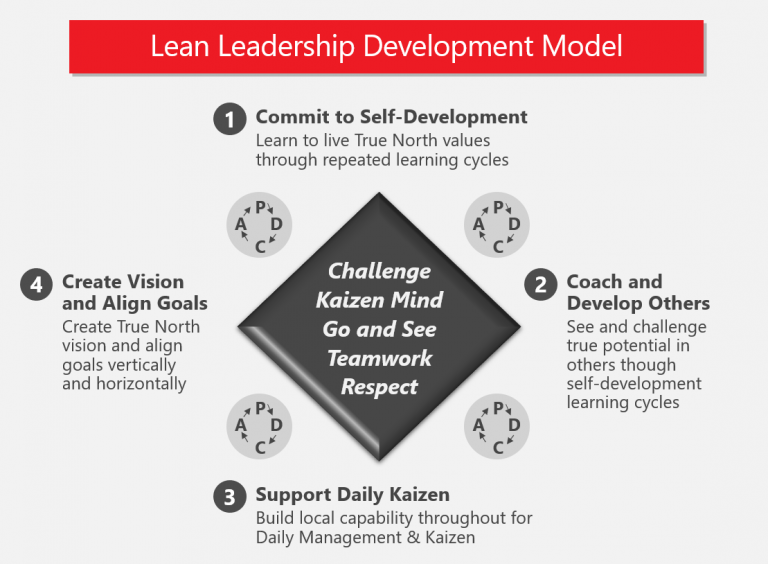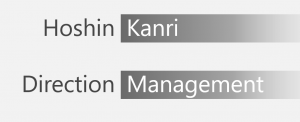The following article is inspired by the book, Developing Lean Leaders at All Levels, by Jeff Liker and George Trachilis.
CREATE THE VISION AND THE CAPABILITY
Welcome back Lean Leaders!
In the recent past I posted articles on the first 3 steps of the Lean Leadership Development Model. We also covered the True North Values that are at the center of this model. All lean leaders should embrace them – as first step – towards developing themselves and their teams towards achieving their company goals.

If you could in real time do all the things we’ve talked about in the past (steps 1 to 3), you would now be the doing the following to self-develop:
- You would be spending time walking through the Gemba, asking great questions, checking the processes that you are responsible for and using visual management everywhere.
- You would have clear metrics and you would understand your processes as would all the people in your organization.
- Your job would be walking around and checking the people and figuring out who should be taking on that more challenging assignment. You would know who is struggling with their current assignment.
- Your job also includes checking the processes and being responsible for the improvement of the process and they way things are to improve in the future.
- You would be getting better at the following the way you solve problems, the way you reach challenging goals.
The result of the above is that your organization would be getting better and better, and in the meantime, your competitors wouldn’t know how to do this, so they would be falling behind. So that would be Nirvana and it’s not going to happen in a few weeks or a few months; it’s going to happen over a period of five to ten years.
As we go through the model, keep in mind that I’m trying to acquaint you this way of thinking about the key importance of self-development, developing others, and supporting daily improvement. A great mindset to hold on to is to view your people as the most valuable and appreciating asset your company has.
Your job is to be a great coach. A coach that has the discipline – not unlike a great sports coach – to understand deeply what each player must do to improve their skills for the purpose of improving the team. What you are trying to do is develop all the players to their fullest potential while at the same time orchestrating one win after another by using each of them as a well-oiled machine.
The problem exists when we have some prima donnas on the team. The overstate their ability and perform as individuals at a cost to the team dynamics and performance. You really need to get them aligned quickly even if they possess skill level and the passion. The mindset you must start with is that they want to be a team and they’re ready to be a team. You have to find one drill that connects their success to the rest of the team’s success. They must connect in a way that their talent for performing as a team player is emphasized over their raw talent as an individual player.

In Japan they came up with the term Hoshin Kanri, which was part of a national movement for quality back in the 1950s and 60s–the Total Quality Management movement–and part of TQM was this idea of Hoshin Kanri. The Hoshin is the direction. Sometimes they talked about that as the compass. We are all in the same game with the same objective. The Kanri is how you do it.
In steps 1 to 3 of the development model, you’ve been developing the capacity to do it, so you can figure out the how to do it. But you still need to know the why, and you still need the direction, you still need the clear purpose to align people. There is a chicken and an egg problem and it’s really hard to get people intensely focused on fixing the business if you don’t have the vision. On the other hand, it is possible to give people the vision, and yet they lack the capability so see the vision through.
So what comes first?

Is it the vision and clear purpose and alignment so that you get people to focus and find ways to solve problems, improve processes, improve themselves? Or… is it improving people so that they have the capability to participate in Hoshin Kanri, in aligning visions and goals? The way we show the model is simple and visual and sequential. So, you get the people developed first; then you roll out Hoshin Kanri.
If there’s one thing I’ve learned is that that any linear view of the world is going to be wrong; the world is more complicated than that. Having made this statement it’s time to assume that as a leader you have done steps one to three.
You’ve done a first pass; think of this as a cycle that’s going around and around; and in each cycle you’re learning through the PDCA process. In other words, you’re planning, you’re doing, you’re checking, you’re acting; you’ve gone through the learning cycle. You’re getting better; your people are getting better; there’s more enthusiasm; there’s higher morale and at some point, you’re ready to pull a string and get all these people aligned for this vision. In addition to that, your senior management is good and talented at developing a vision and leading a process to get everybody aligned to figure out what I should do; what does the vision mean for me?
These are exciting times. Join me again as we get into the how to of step 4.
One-Minute Review
- If you did everything we talked about, you would be self-developed, asking great questions, checking the process, developing others, and this would be Nirvana.
- Your competitors would not know what hit them.
- It is now time to start playing in harmony; we have not talked about this yet.
- Now that different groups (departments) have the skill level, you need to get them aligned.
- Hoshin Kanri was part of the national movement in Japan, part of Total Quality Management (TQM).
- Hoshin is the direction, and Kanri is how you do it.
- Hoshin Kanri has a chicken and egg problem associated with it.
- The Lean Leadership Development Model first identifies the “how to do it” and then aligns the orchestra to play together.
A similar article is found on Kindle – https://www.amazon.com/Developing-Leadership-Skills-61-Capability/dp/B07DTL6MZP.
All 75 learning articles are crafted together in the book, Developing Lean Leaders at All Levels: A Practical Guide, authored by Jeff Liker with George Trachilis. The book received the SHINGO RESEARCH AWARD in 2016.

George Trachilis (left) and Jeff Liker receive the Shingo Research Award in Washington, D.C. (2016)

